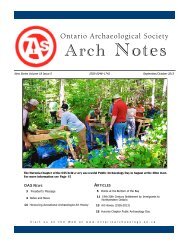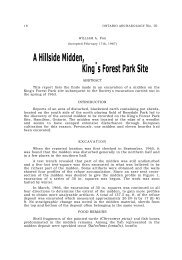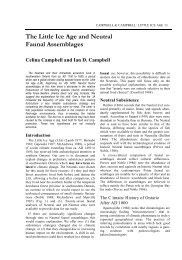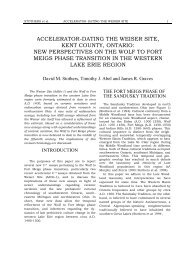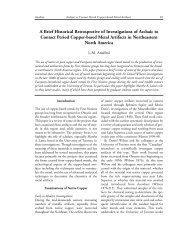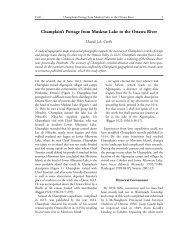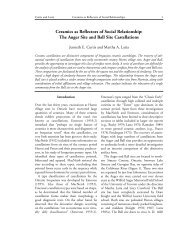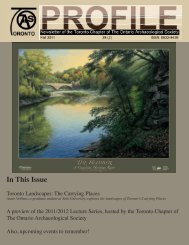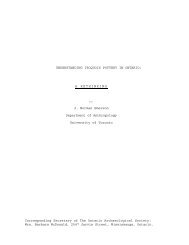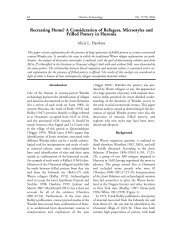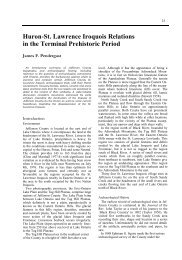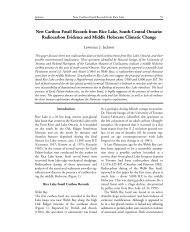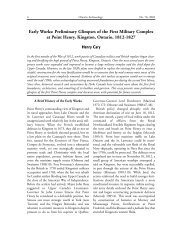The Norton Site - Ontario Archaeological Society
The Norton Site - Ontario Archaeological Society
The Norton Site - Ontario Archaeological Society
Create successful ePaper yourself
Turn your PDF publications into a flip-book with our unique Google optimized e-Paper software.
52 ONTARIO ARCHAEOLOGY NO. 56<br />
Table 8. <strong>Norton</strong> site (AfHh-86) faunal remains: species by provenance type<br />
TAXONOMIC COMMON NAME HOUSE MIDDEN A F119 SITE<br />
IDENTIFICATION FEATURES TOTAL<br />
Elliptio sp. cf complanatus eastern elliptio (prob.) - 1 - 1<br />
Lasmigona costata fluted shell 1 - - 1<br />
Strophitus undulatus squaw foot 1 - - 1<br />
Liqumia sp. cf recta black sand shell (prob.) 1 - - 1<br />
Lamposilis sp. cf radiata flat mucket (prob.) - 1 - 1<br />
Ictalurus nebulosus brown bullhead 1 - - 1<br />
Ictalurus sp. cf. natalis yellow bullhead (prob.) 1 - - 1<br />
Ictalurus punctatus channel catfish 1 - - 1<br />
Ictalurus sp. cf. punctatus channel catfish (prob.) 1 - - 1<br />
Ambloplites rupestris rock bass 1 - - 1<br />
Micropterus salmoides smallmouth bass 1 - - 1<br />
Chrysemys picta painted turtle - 1 - 1<br />
Meleagris gallopavo wild turkey 1 1 - 2<br />
Cf. Picoides villosus hairy woodpecker (prob.) 1 - - 1<br />
Sciurus carolinensis grey squirrel 2 - - 2<br />
Tamiasciunis hudsonicus red squirrel 1 - - 1<br />
Marmota monax woodchuck 1 - - 1<br />
Ondatra zibethicus muskrat 2 - - 2<br />
Canis sp. cf. familiaris domestic dog (prob.) 1 - - 1<br />
Ursus americanus black bear - - 1 1<br />
Artiodactyla sp. cf Cervus even toed ungulate - - 1 1<br />
Odocoileus virginianus white-tailed deer 67 28 108 203<br />
Odocoileus virginianus (prob.) white-tailed deer (worked)- 1 - 1<br />
Cervidae sp. cf O. virginianus white-tailed deer (prob.) 1 - - 1<br />
Cervidae sp. antler 2 - 2 4<br />
TOTAL 88 33 112 233<br />
has been noted elsewhere (e.g. Hanley e t a l . in press).<br />
Nevertheless this area too seems to have been the focus<br />
of lithic reduction activity.<br />
Worked Bone and Faunal Remains<br />
A number of worked bone implements were<br />
recovered (Thomas 1992) the most notable of which<br />
was a perforated antler object (Figure 9:0 recovered<br />
from the fill of the semi-subterranean sweat lodge<br />
(Feature 119). It consists of a major distal portion of a<br />
right antler from a four-point white-tailed deer buck.<br />
Heavy grinding was employed to shape the proximal<br />
end and to smooth over the stumps of three branching<br />
tines. Two holes were drilled in the proximal third of<br />
the object perpendicular to the plane of curvature. In<br />
some respects this item resembles a hafted pick, but<br />
there is no obvious haft wear on the antler cortex<br />
associated with the perforations. A number of other<br />
items, including five perforated deer phalanges, a beadlike<br />
object (Figure 9:b) manufactured from the<br />
diastema of a deer mandible, a finely worked bodkin<br />
fragment and four expedient awls or knives (Figure 9:ce)<br />
were also recovered.<br />
Detailed analysis was conducted on a representative<br />
sample of excavated faunal material consisting of 1,097<br />
specimens or approximately 47% of the excavated<br />
material. <strong>The</strong> analyzed remains account for 86% of the<br />
material recovered from house features, 69% of the<br />
total from Midden A, and 25% from Feature 119. This<br />
variation reflects an effort to select enough identifiable<br />
material from each provenance type for adequate<br />
evaluation (Thomas 1992:58-59).<br />
White-tailed deer comprises 90% of elements<br />
identified to species level (Table 8) indicating its<br />
primary economic importance. <strong>The</strong> frequency of deer<br />
and probable deer identifications ranges from 79% in<br />
the house features to 88% in Midden A to 98% in<br />
Feature 119, which appears to have been the location of<br />
considerable processing activity or a disposal area for<br />
waste material from such activity (Thomas 1992:65-<br />
66). <strong>The</strong> remainder of the faunal sample, 10% on a sitewide<br />
basis, is thinly distributed among a wide range of<br />
species none of which accounts for more than 0.9% of<br />
the site total. Given these conditions it may be more<br />
useful to consider the identified species by groups<br />
rather than



